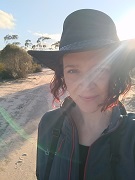Australian animals show an enormous diversity of movement behaviour, due to a long evolutionary history of adaptation to highly variable – and occasionally extreme – environmental conditions. In this webinar, you will hear from three researchers investigating animal movement over different spatial and temporal scales, from individual habitat patches in our cities; to nomadic movements spanning millions of hectares; to shifts in species distributions across geological timescales. Join us to hear more about our amazing fauna and how science is shedding light on ways to conserve Australia’s biodiversity.
This webinar took place at 1.00pm AEST, Tuesday 21 September 2021, with 274 live viewers in attendance.
Speakers
Holly Kirk | RMIT

Holly is a member of the Interdisciplinary Conservation Science Group at RMIT University, and the Clean Air and Urban Landscapes NESP Hub. She specialises in understanding how animals move around their environments, and is passionate about translating scientific theory into positive on-ground action for people and nature. As an expert in ecology and spatial modelling, Holly has been using this knowledge to plan cities that support and enhance urban biodiversity. Most recently, she has been developing a tool to quantify ecological connectivity and applying this within the Biodiversity Sensitive Urban Design framework to several development projects, including the renewal of Fisherman’s Bend (Melbourne).
Julia Ryeland | University of Western Sydney

Julia is an ecological consultant, focused primarily on management of microbats in urban environments. She has broad interests in applying behavioural ecology research to conservation and management problems. This has predominately involved research on avian systems, including understanding behavioural thermoregulatory adaptation in a wetland context and sensitivity of birds under climate change, and more recently, management of emus in urbanising areas. Julia completed her PhD on male reproductive behaviour and success in emus in 2020, and has worked with governmental bodies to determine best-practice management of emus across the east coast of Australia, where they are known to be disappearing.
Ross Crates | ANU

Ross is a postdoctoral research fellow with the Difficult Bird Research Group at the Fenner School, ANU. His work is broadly related to woodland bird conservation, with a particular focus on the regent honeyeater. His recent research on regent honeyeaters has explored the loss of song culture, quantifying megafire impacts, population genetics, management of the Noisy Miner, and population viability analysis.
Moderator bio
Martin Westgate is Science Advisor to the Atlas of Living Australia and a visiting fellow at the Fenner School of Environment & Society at the Australian National University. His research focuses on how scientific information can be used to understand and mitigate human impacts on the environment, via a combination of empirical ecology and evidence synthesis. Martin is also a scientific software developer and occasional frog-watcher.
Want more?
All ALA webinars are available to view on our YouTube channel along with other video content.